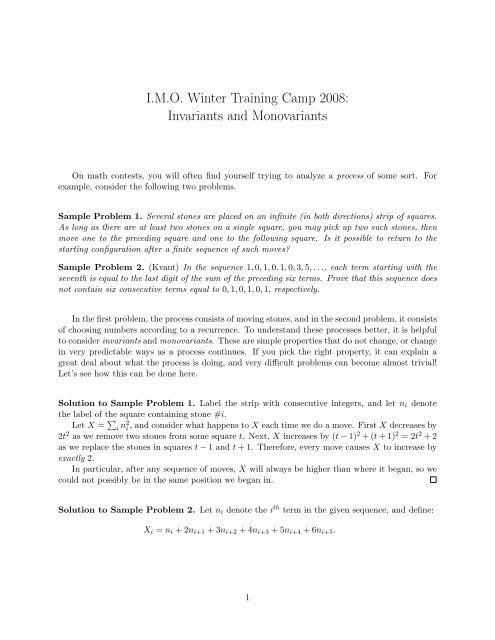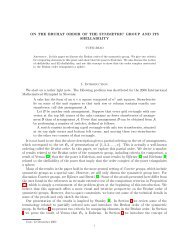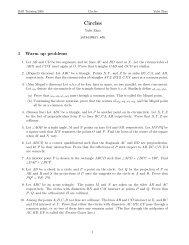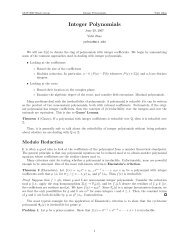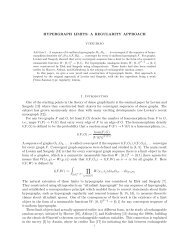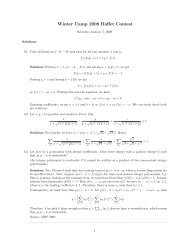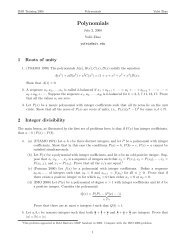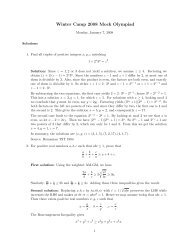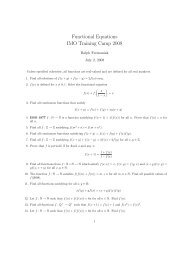I.M.O. Winter Training Camp 2008: Invariants and ... - Yufei Zhao
I.M.O. Winter Training Camp 2008: Invariants and ... - Yufei Zhao
I.M.O. Winter Training Camp 2008: Invariants and ... - Yufei Zhao
- No tags were found...
Create successful ePaper yourself
Turn your PDF publications into a flip-book with our unique Google optimized e-Paper software.
I.M.O. <strong>Winter</strong> <strong>Training</strong> <strong>Camp</strong> <strong>2008</strong>:<strong>Invariants</strong> <strong>and</strong> MonovariantsOn math contests, you will often find yourself trying to analyze a process of some sort. Forexample, consider the following two problems.Sample Problem 1. Several stones are placed on an infinite (in both directions) strip of squares.As long as there are at least two stones on a single square, you may pick up two such stones, thenmove one to the preceding square <strong>and</strong> one to the following square. Is it possible to return to thestarting configuration after a finite sequence of such moves?Sample Problem 2. (Kvant) In the sequence 1, 0, 1, 0, 1, 0, 3, 5, . . ., each term starting with theseventh is equal to the last digit of the sum of the preceding six terms. Prove that this sequence doesnot contain six consecutive terms equal to 0, 1, 0, 1, 0, 1, respectively.In the first problem, the process consists of moving stones, <strong>and</strong> in the second problem, it consistsof choosing numbers according to a recurrence. To underst<strong>and</strong> these processes better, it is helpfulto consider invariants <strong>and</strong> monovariants. These are simple properties that do not change, or changein very predictable ways as a process continues. If you pick the right property, it can explain agreat deal about what the process is doing, <strong>and</strong> very difficult problems can become almost trivial!Let’s see how this can be done here.Solution to Sample Problem 1. Label the strip with consecutive integers, <strong>and</strong> let n i denotethe label of the square containing stone #i.Let X = ∑ i n2 i , <strong>and</strong> consider what happens to X each time we do a move. First X decreases by2t 2 as we remove two stones from some square t. Next, X increases by (t − 1) 2 + (t + 1) 2 = 2t 2 + 2as we replace the stones in squares t − 1 <strong>and</strong> t + 1. Therefore, every move causes X to increase byexactly 2.In particular, after any sequence of moves, X will always be higher than where it began, so wecould not possibly be in the same position we began in.Solution to Sample Problem 2. Let n i denote the i th term in the given sequence, <strong>and</strong> define:X i = n i + 2n i+1 + 3n i+2 + 4n i+3 + 5n i+4 + 6n i+5 .1
Note that X 1 = 1 · 1 + 3 · 1 + 5 · 1 = 9. Also for any i ≥ 2, we have:X i = n i + 2n i+1 + 3n i+2 + 4n i+3 + 5n i+4 + 6n i+5≡ n i + 2n i+1 + 3n i+2 + 4n i+3 + 5n i+4 + 6(n i−1 + n i + n i+1 + n i+2 + n i+3 + n i+4 ) (mod 5)≡ n i−1 + 2n i + 3n i+1 + 4n i+2 + 5n i+3 + 6n i+4 (mod 5)≡ X i−1 (mod 5).It follows that X i ≡ X 1 ≡ 4 (mod 5) for all i. If we had a subsequence {0, 1, 0, 1, 0, 1}, however,then the corresponding X i would be 1 · 2 + 1 · 4 + 1 · 6 = 12 ≢ 4 (mod 5), which is impossible.Usually an invariant problem is pretty easy once you find the right invariant (or monovariant),but finding it can be pretty tough! After all, why would you think to try exactly X i in SampleProblem 2? In truth, finding the right invariant is an art, <strong>and</strong> that is what makes these problemshard. Nonetheless, there are a few things that you should always be thinking about:• Colorings: Color all the squares in a grid with two or more colors. Usually the chessboardpattern is a good choice, but other patterns are also sometimes useful. Consider squares ofeach color separately.• Algebraic expressions: Given a set of values, look at their differences, their sum, the sum oftheir squares, or occasionally their product. If you are working with integers, try looking atthese values modulo n. (Usually n should be a small prime power.)• Corners <strong>and</strong> edges: For grid-based problems, consider any shapes formed. How many boundaryedges do they have? How many corners?• Inversions: If you are permuting a sequence of numbers, consider the number of inversions –that is, the number of pairs (i, j) such that i <strong>and</strong> j are listed in the wrong order. Both theabsolute number of inversions <strong>and</strong> its parity are useful.• Integers <strong>and</strong> rationals: Can you find a positive integer that keeps decreasing? Or does thedenominator of a rational number keep decreasing?• Symmetries: Can you ensure that after each step, a figure is symmetrical in some way?Perhaps you can logically pair up objects, <strong>and</strong> two paired objects are always in the samestate? Perhaps the problem can be divided into two essentially identical subproblems? Thisis especially useful for game-theory type problems.You can apply invariants in a number of interesting ways, but often, you will know what to dowhen you get there. Instead of listing all the possibilities, I will just say practice makes perfect,<strong>and</strong> give you lots of problems to try! There are hints to some of the problems, but try to solvethem on your own first.Starter problems1. An 8 × 8 chessboard has two opposite corners removed. Is it possible to tile the remaining 62squares with 31 dominoes?2
2. (Bernoulli Trials, 1998) Arya <strong>and</strong> Bran are playing a game. They begin with <strong>2008</strong> coinsarranged in a circle, <strong>and</strong> alternate turns, starting with Arya. On his or her turn, a playermay remove any one coin, or if two adjacent coins remain, he or she may instead removeboth. The player who removes the last coin wins. Show that Bran has a winning strategy,no matter how Arya plays.3. The numbers 1, 2, 3, . . . , n are written in a row. It is permitted to swap any two numbers.If 2007 such operations are performed, is it possible that the final arrangement of numberscoincides with the original?4. (AM-GM inequality)(a) Suppose we are given positive numbers a, b, x with a < x < b. Show that x(a+b−x) > ab.(b) Given positive real numbers a 1 , a 2 , . . . , a n , prove that:a 1 + a 2 + . . . + a nn≥ n√ a 1 · a 2 · . . . · a n .Remark: This is a general technique called “smoothing”. Suppose you want to show somefunction f satisfies f(a 1 , a 2 , . . . , a n ) ≥ 0 for all choices of {a i }. Start with an arbitrary choice.Then alter it slightly so as to decrease f. Continue doing this until you reach {a ′ i } for whichyou already know f(a ′ 1 , a′ 2 , . . . , a′ n) = 0. Then, f(a 1 , a 2 , . . . , a n ) ≥ f(a ′ 1 , a′ 2 , . . . , a′ n) = 0, asrequired. You need to show that {a i } actually reaches {a ′ i } after a finite number of steps, <strong>and</strong>that’s where invariant theory comes in!As an aside, if you happened to know that there is some choice of {a i } for which f takes onits minimum value, you could side-step some of this work. However, this is not always thecase (for example, imagine if f ranged over all positive real numbers).Olympiad-level problems5. (USAMO 1997, #1) Let p 1 , p 2 , p 3 , . . . be the prime numbers listed in increasing order, <strong>and</strong>let x 0 be a real number between 0 <strong>and</strong> 1. For positive integer k, define{0 if xk−1 = 0,x k ={pkif x k−1 ≠ 0,x k−1}where {x} denotes the factional part of x. (The fractional part of x is given by x − ⌊x⌋ wherex is the greatest integer less than or equal to x.) Find, with proof, all x 0 satisfying 0 < x 0 < 1for which the sequence x 0 , x 1 , x 2 , . . . eventually becomes 0.6. (CMO 2007, #1) What is the maximum number of non-overlapping 2 × 1 dominoes that canbe placed on an 8 × 9 chessboard if six of them are placed as shown? Each domino must beplaced horizontally or vertically so as to cover two adjacent squares of the board.000 111000 111000 111000 1113
7. (Stanford Putnam training 2007) On an n × n board, there are n 2 squares, n − 1 of which areinfected. Each second, any square that is adjacent to at least two infected squares becomesinfected. Show that at least one square always remains uninfected.8. (Adapted from IOI 2002) A computer screen shows an n × n grid, colored black <strong>and</strong> white insome way. One can select with a mouse any rectangle with sides on the lines of the grid <strong>and</strong>click the mouse button: as a result, the colors in the selected rectangle switch (black becomeswhite, white becomes black). Let X denote the minimum number of mouse clicks required tomake the grid all white. Also, let Y denote the number of grid vertices adjacent to an oddnumber of black squares. Show that Y 4 ≤ X ≤ Y 2 .Remark: USAMO 1998 #4 is essentially a special case of this result.9. You have a stack of 2n + 1 cards, which you can shuffle using the two following operations:1. Cut: Remove any number of cards from the top of the pile, <strong>and</strong> put them on the bottom.2. Perfect riffle shuffle: Remove the top n cards from the deck <strong>and</strong> place them in order inthe spaces between the other n + 1 cards.Prove that, no matter how many operations you perform, you can reorder the cards in atmost 2n(2n + 1) different ways.10. (USAMO 2004, #4) Alice <strong>and</strong> Bob play a game on a 6 × 6 grid. On his or her turn, a playerchooses a rational number not appearing in the grid <strong>and</strong> writes it in an empty square of thegrid. Alice goes first <strong>and</strong> then the players alternate. When all squares have numbers writtenin them, in each row, the square with the greatest number in that row is colored black. Alicewins if she can then draw a path from the top of the grid to the bottom of the grid that staysin black squares, <strong>and</strong> Bob wins if she cannot. (If two squares share a vertex, Alice can drawa path from one to the other that stays in those two squares.) Find, with proof, a winningstrategy for one of the two players.11. (IMO training camp, 1999) The vertices of a regular n-sided polygon have integer coordinates.Show that n = 4. It might help to first show that n is even.12. (AIME 1998, #15) Define a domino to be an ordered pair of distinct positive integers. Aproper sequence of dominoes is a list of distinct dominoes in which the first coordinate of eachpair after the first equals the second coordinate of the immediately preceding pair, <strong>and</strong> inwhich (i, j) <strong>and</strong> (j, i) do not both appear for any i <strong>and</strong> j. Let D 40 be the set of all dominoeswhose coordinates are no larger than 40. Find the length of the longest proper sequence ofdominoes that can be formed using the dominoes of D 40 .13. The numbers from 1 through <strong>2008</strong> are written on a blackboard. Every second, Dr. Math erasesfour numbers of the form a, b, c, a+b+c, <strong>and</strong> replaces them with the numbers a+b, b+c, c+a.Prove that this can continue for at most 10 minutes.14. (APMO 2007, #5) A regular (5 × 5)-array of lights is defective, so that toggling the switchfor one light causes each adjacent light in the same row <strong>and</strong> in the same column as well asthe light itself to change state, from on to off, or from off to on. Initially, all the lights areswitched off. After a certain number of toggles, exactly one light is switched on. Find all thepossible positions of this light.4
15. (IMO 2000, #3) Let n ≥ 2 be a positive integer <strong>and</strong> λ be a positive real number. Initially,there are n fleas on a horizontal line, not all at the same point. We define a move as choosingtwo fleas, at some points A <strong>and</strong> B, with A to the left of B, <strong>and</strong> letting the flea from A jumpto the point C to the right of B such that BC/AB = λ.Determine all values of λ such that, for any point M on the line <strong>and</strong> any initial position ofthe n fleas, there exists a sequence of moves that will take them all to positions right of M.16. (IMO training camp, 1999) Recall the scenario of Sample Problem 1. Prove that any sequenceof moves will lead to a position in which no further moves can be made, <strong>and</strong> moreover thatthis position is independent of the sequence of moves.17. (MOP 1998 homework) Several stones are placed on an infinite (in both directions) strip ofsquares, indexed by the integers. We perform a sequence of moves, each move being one ofthe following two types:(a) Remove one stone from each of the squares n − 1 <strong>and</strong> n <strong>and</strong> place one stone on squaren + 1.(b) Remove two stones from square n <strong>and</strong> place one stone on each of the squares n − 2 <strong>and</strong>n + 1.Prove that any sequence of such moves will lead to a position in which no further moves canbe made, <strong>and</strong> moreover that this position is independent of the sequence of moves.18. Anya <strong>and</strong> Borya are playing a game. They begin with a “pyramid” consisting of 10 rows,where row i has exactly i coins arranged in a line. On his or her turn, a player chooses anynumber of contiguous coins within a single row, <strong>and</strong> then removes them. (Note that if a coinis removed, the coins remaining to its left <strong>and</strong> to its right are not considered contiguous witheach other.) The player who removes the last coin wins. Anya goes first <strong>and</strong> then the playersalternate. Find, with proof, a winning strategy for one of the two players.Unusual problems19. (IMO Correspondence Program 1998 <strong>and</strong> CM+MM 1997) How many distinct acute angles αare there for which cos(α) · cos(2α) · cos(4α) = 1/8?20. (MOP 1998, Po-Shen Loh) Let ω 1 <strong>and</strong> ω 2 be equal-radius circles meeting at points B <strong>and</strong> C.Let X denote the midpoint of BC <strong>and</strong> let A be a point on ω 1 that is not contained inside ω 2 .Extend −→ −→AB <strong>and</strong> AC to hit ω2 at A 1 <strong>and</strong> A 2 respectively. Then extend −−→ A 1 X <strong>and</strong> −−→ A 2 X to hitω 1 at P 1 <strong>and</strong> P 2 respectively. Show that AP 1 = AP 2 .21. Several checkers are placed on a board. Each turn, a checker may jump diagonally over anadjacent piece if the opposite square is empty. If a checker is jumped over in this way, it isremoved from the board. Is it possible to make a sequence of such jumps to remove all butone checker from the board shown below?5
O O O OO O O OOOOOOOOOO O O OO O O OSelected hints2. As with many 2-player games, symmetry is the key.10. It’s always symmetry with games! Try pairing up squares.11. <strong>Invariants</strong> can show n is even. This further implies n is a power of 2, but why?12. Think of dominoes as edges on a graph. Could you use all the dominoes if several verticeshad odd degree (i.e., an odd number of incident edges)? What if all the vertices had evendegree?14. A careful coloring can tell you where the light can’t be. Unfortunately that’s the easy part!15. If λ < 1n−1, there exists a constant C > 0 so that (n − 1 + C)λ = 1. Can you come up withan invariant depending on C?16. <strong>Invariants</strong> are good for showing that any sequence of moves must terminate. Consider othertechniques for uniqueness.17.1+ √ 52.18. This game has three important properties: (1) the two players are essentially symmetric, (2)the game decomposes into similar, independent sub-games, <strong>and</strong> (3) on your turn, you maymake a move in any one sub-game. These facts imply the game is in some sense equivalentto Nim, so start thinking about exclusive-or!19. Yes, it is a bit of a stretch to call this an invariant problem, but there is a reason for it. Canyou simplify cos(α) · cos(2α) · . . . · cos(2 t α) in general?20. This is another sort-of invariant problem. Is there a position for A where the problem is easy?Now what happens when you move A?21. Consider the Klein group. This has 4 elements {e, a, b, c} that can be multiplied according tothe following rules. Let x, y, z be an ordering of a, b, c. Then, e · x = x · e = x, x 2 = e, <strong>and</strong>x · y = z.6


